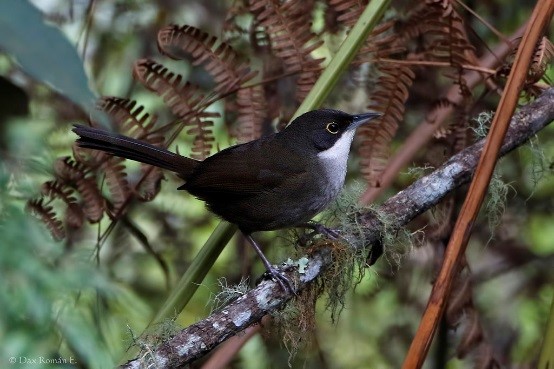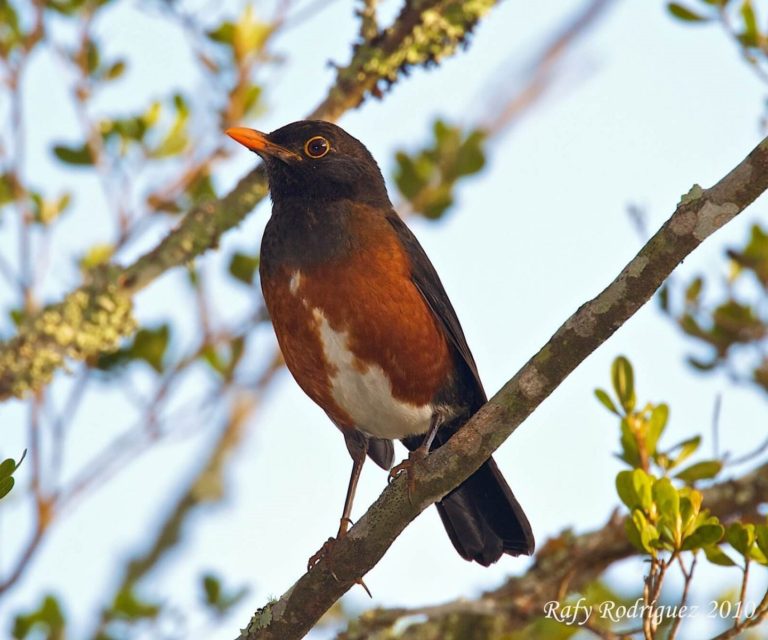Cachote, Dominican Republic

Cachote is perched atop the Bahoruco Oriental, the eastern extension of the Sierra de Bahoruco, separated from the main sierra by the Polo Valley. Much of this forest is still intact, with the legal protection of Manuel Domingo Fuerte Natural Monument. Compared to montane sites to the west at Alcoa Road and Zapotén, the habitat at Cachote is far wetter, archetypical cloud forest, thick with moss, bromeliads, and ferns of all sizes. Cachote is the only site where Eastern Chat-Tanager has been found consistently, and also supports populations of almost all other Hispaniolan endemics.
Orientation
Directions
Cachote is at the end of a rough road that is not suitable for most vehicles. This road joins Route 44 at La Ciénaga, approximately 20 minutes (20 km) south of Barahona, or 3½ hours’ (220 km) drive from Santo Domingo. From La Ciénaga, the drive up to Cachote adds an hour or more.
In La Ciénaga, beside the town’s only gas station, an unmarked, paved road climbs steeply up the hillside for a few hundred meters, then turns to dirt and continues winding up through rural properties for approximately 16 km until it reaches the Centro Ecoturistico Canto del Jilguero (“Song of the Solitaire Ecotourism Center”) just outside the village of Cachote.
Although some brave drivers have reportedly reached Cachote in normal passenger cars, anyone who considers attempting this must be prepared to abandon the vehicle and continue on foot, as the road has several patches that are usually deeply rutted, requiring a high-clearance vehicle—and at times are simply impassable.
The road forks in several places, some with signs and some without. Following are directions for each of the forks, with distances measured from the junction with Route 44: at 6.6 km, keep straight (instead of turning right to Guayuyal); at 9.2 km, bear right; at 11.2 km, bear right (a radio antenna is to the left); at 11.7 km, bear right; at 14.5 km, bear left; at 15.2 km, bear right; and at 16.3 km, bear right up the lane to the Centro Ecoturistico’s main entrance. If you bear left at 16.3 km, you will quickly reach a second entrance to the Centro Ecoturistico.
It is also possible to park at the La Ciénaga gas station and hike the road (4 hours up; 3 hours down), avoiding both the need for a high-clearance vehicle and uncertainty about road conditions. The gas station manager will watch your car in exchange for a few pesos. Visitors who take this approach can try to prearrange a stay in the dormitory at the Centro Ecoturistico or camp on its grounds, but must be prepared for a damp and surprisingly chilly night in the cloud forest.

The Centro Ecotouristico Canto del Jilguero at Cachote is named for the Rufous-throated Solitaire, which is common there. © Dax M. Román E.
Birdfinding
The globally rare Eastern Chat-Tanager has been found reliably along the upper part of the lane to the Centro Ecoturistico. Since its discovery at this site, a pair has usually maintained a territory in this patch of forest, and most visiting birdwatchers seem to find them quickly, with or without voice playback, as they move through the understory scolding like wrens.
The Bahoruco Oriental population of Eastern Chat-Tanager seems to be fairly dense—which is important because it may be the world’s only viable population—and it is readily encountered along other trails through the cloud forest near Cachote. One such trail begins along the main road between the two entrances to the Centro Ecoturistico, on the opposite side of the road. This trail leads through the territories of multiple pairs of Eastern Chat-Tanager.

Cachote is the only accessible site where Eastern Chat-Tanager can be found by most visitors. © Dax M. Román E.
With persistence and luck, La Selle Thrush can also be found along the roads and forest trails at Cachote, though there is not a specific stake-out for this species comparable to the one at Zapotén. Cachote is also among the prime sites for wintering Bicknell’s Thrush between October and March.
Other uncommon or range-restricted species regularly encountered around Cachote include: Plain Pigeon, Hispaniolan Trogon, Hispaniolan Parakeet, Rufous-throated Solitaire, and Hispaniolan Spindalis. Exploration of the trail system beyond the immediate vicinity of Cachote could probably produce most of Hispaniola’s montane endemics.
Along the coastal highway near La Ciénaga, Ashy-faced Owl and Least Pauraque can be found along several dirt roads that lead up into the wooded canyons. Ashy-faced Owl is sometimes encountered along the lower part of the road to Cachote during predawn drives to the site.

La Selle Thrush is common but elusive at Cachote. © Rafy Rodríguez
Services
Accommodations
It is possible to stay overnight in Cachote in the dormitory of the Centro Ecoturistico Canto del Jilguero, but this must be arranged well in advance through the Barahona tourism office: (829) 471-1615; www.gobarahona.com.
Otherwise, accommodations are numerous in Barahona and some of the beach towns south of it along Route 44.
At the south end of Barahona, the all-inclusive Hotel Costa Larimar (Avenida Enriquillo 6, 809-524-5111) is the most upscale hotel in town.
One block north of the Costa Larimar are two mid-range options that are comfortable enough for most foreign visitors:
Hotel Caribe, Avenida Enriquillo, 809-524-4111
Hotel Gurocuya, Avenida Enriquillo 15, 809-524-4121
A few blocks farther north and one block inland is the most popular budget option in Barahona, the Hotel El Cacique (J.F.C. Gómez 2, 809-524-4620).
South of Barahona, there are many hotels along the coast, many in attractive settings, including:
Hotel Playazul, 6.5 km south of Barahona, 809-204-8010
Playazul, also 6.5 km south of Barahona, 809-424-5375
Hotel Casablanca, 10 km south of Barahona, 829-740-1230
Casa del Mar Lodge Barahona, 13.5 km south of Barahona, 829-330-3395
In La Ciénaga itself, less than five minutes’ drive from the Cachote access road, the high-end Casa Bonita Tropical Lodge (809-540-5908) is popular with visiting birdwatchers.
Nearly as close to Cachote, 5 km south of La Ciénaga, but at the opposite end of the price scale is the tiny Casa Doña Calandra (809-936-8434).
9 km farther south (about 20 minutes’ drive from the road to Cachote), the town of Paraíso offers a range of attractive and reasonable options, including:
Hotel Paraíso, at the intersection of Avendia Luperón and the Carretera Vieja, 809-243-1080
Hotel Sea Breeze, at the intersection of Calle Arzobispo Nouel and Mirador Ecológico
Hotel Piratas del Caribe, Calle Arzobispo Nouel, 809-243-1140
Hotel South Beach Paraíso, on Route 44 just south of Paraíso, 809-463-4341
3.5 km beyond Paraíso, the tiny beach town of Los Patos has another cluster of attractive and reasonable hotels, including:
Hotelito Oasi Italiana, 829-926-9796
Hotel Paramount 40, 809-822-7283
Hotel Vista Sur, 829-822-6433
Hotel Los Patos, 829-993-4869
La Mami River Beach, 829-815-5940
For some visitors an important advantage to staying in Paraíso or Los Patos as an alternative to Barahona is that they are a much shorter drive to Alcoa Road, Cabo Rojo, and Bahía de las Águilas.
Food
Cachote is remote and has no businesses that serve the general public, although the Centro Ecoturistico Canto del Jilguero has a kitchen and can provide meals for guests who prearrange accommodations there.
La Ciénaga and the many small coastal towns in the area have many small bars and a few restaurants.
Barahona has more diverse options. Recommended restaurants in town include:
For seafood, Restaurante Brisas del Caribe, Avenida Dr. Joaquín Balaguer, 809-524-2794
For chicken, D’Chovi Cafeteria, at the intersection of Calle Duvergé and Calle Nuestra Señora del Rosario, 809-524-4735
In Los Patos, a popular restaurant on Route 44 is Doña Pula (849-815-7109).
Notes
When to Visit
As with other forested sites in the D.R., it is better in the breeding season, February through May, when the endemics are most vocal and conspicuous.
Hazards & Hassles
The road to Cachote can be perilous. Depending on how recently it has been repaired and how many strong rains have followed, the conditions can vary widely, so the only reliable reports are recent ones. Although much of the road is merely rutted, there are a few locations where gulleys form, so drivers in any type of vehicle must remain alert and be prepared to stop.